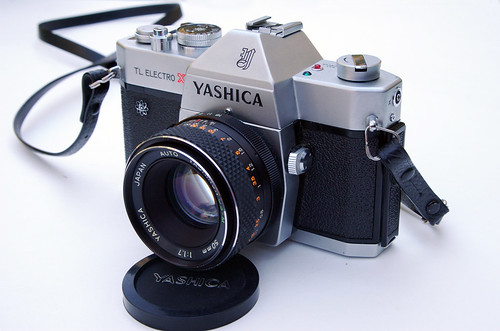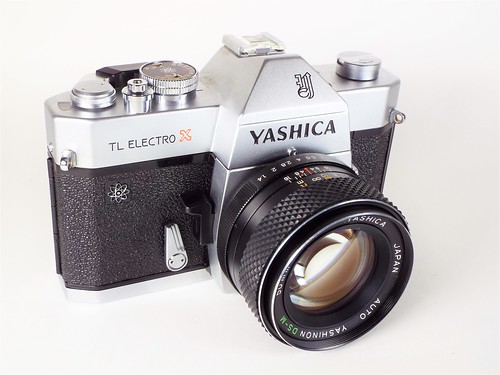Yashica TL Electro-X

|
| Yashica TL Electro-X image by Nesster (Image rights) |
The Yashica TL Electro-X is part of the TL series of SLR cameras. Production started in October 1968 and ended in December 1974. In 1975 Yashica moved away from the M42 mount and adopted their Yashica/Contax bayonet mount.
The TL Electro X is a significant milestone SLR, as it belongs to the first three SLR with an electronically controlled shutter, all introduced within a few months in 1968. In fact it was the only successful implementation. The other two were the Praktica PL electronic (more a technology study) and Zeiss Ikon's Contarex SE (a complicated high end niche camera). Both only made it to about 3000 units, while the Yashica sold about 300,000 times!.
The electronics within the Yashica were combined with state of the art TTL metering and allowed step-less timing of the shutter at any intermediate speed between 2 seconds and 1/1000th. It was also the first camera with viewfinder electronic lights for exposure information (miniature lamps, not LEDs).
The Yashica TL Electro-X ITS was introduced in 1971, and sold alongside the first model. Externally the ITS differed by the monogram on the pentaprism being replaced by a gold-coloured "Atom" symbol. The ITS also came only in black, while the X was made in chrome and black finishes.
Contents
Physical description
Besides its innovative electronic shutter, the camera is a fairly conventional SLR of the time, with a somewhat cluttered appearance and a physical plan similar to the Pentax Spotmatic, but slightly larger. The shutter speed dial (with Yashica atom logo), film advance, shutter release, rewind knob and battery check are on the top plate. The battery check is a red button and a green light, which will light up quite brightly if the battery is strong. The battery is inserted behind a small and easy-to-lose cap on the back of the camera, and two PC sockets are immediately to the right of it, wrapping onto the side of the camera: one is for FP sync ("Flat Peak" or, just as aptly, "Focal Plane," for long-burning bulbs that could expose at speeds above X-sync) and the other is for X-sync, as is the hot shoe.
The camera is noticeably well-decorated, with a gothic "Y" monogram on the upper part of the pentaprism, "Yashica" in large letters above the lens mount, the camera name in black and red on the front, and a plastic Yashica atom logo on the leatherette.
The film door latch is separate from the rewind knob, and is covered by its own panel of faux-leatherette.
The self-timer is operated by the conventional lever, on the front of the camera, and can be wound whether the camera is cocked or not. Unlike on some cameras of this era, it does not have its own release button, and it cannot be released without cocking the shutter. The self-timer intervenes between the mirror raising and the shutter releasing, so that the viewfinder blacks out and the aperture is stopped down while the timer runs.
Immediately adjacent to the self-timer lever, on the side of the lens mount, is the stopping-down lever, which stops down the aperture when pushed about three-quarters of the way, and activates the meter when pushed fully. On the opposite side of the lens mount is the mirror lock-up lever. This is a knurled tab that can be flipped up with the left hand to raise the mirror.
The rewind-release button is on the bottom, as is the tripod socket.
Shutter
The shutter is metal, a Copal Square-style vertical focal-plane shutter. The blinds are moved by exposed levers which give the shutter a somewhat primitive look. However, this shutter was one of the first truly modern shutters, with a design lineage reaching forwards to the last DSLR's with physical shutters. The shutter is mechanically cocked and released, but speeds other than 1/1000th are delayed by an electronic timer, giving stepless shutter speeds down to c. 2 seconds.
The selection of an intermediate shutter speed is largely guesswork. Speeds above 1/30th are click stopped, but it is possible to set the speed dial between settings. The slower speeds are not click-stopped, reflecting Yashica's intention for lower light exposures to be metered by adjustment of the shutter speed rather than the lens aperture.
Electronics
Yashica actually is quite a pioneer in using electronic components in cameras. Three years before the TL Electro X they already launched the first camera with an electronically controlled shutter (the rare viewfinder Yashica Electro half) and later one of the most successful rangefinder cameras of its time: Yashica Electro 35. Both used the electronics to not only control the shutter timing, but also to implement aperture priority auto exposure. This feature is missing in the SLR, because of the TTL metering. During exposure the CdS-cells located at the pentaprism would go dark. Therefore, Yashica could not use the same logic. Solving this issue, would mean to develop a short time memory for the measured light value. Instead, Yashica mechanically coupled the shutter control logic with the TTL-meter using to identical rotary potentiometer operated by the shutter selection wheel above both[1]. The first SLR to offer aperture priority auto exposure would be the Pentax ES of 1971.
Metering
The camera is equipped with a TTL meter, which is operated by the stopping-down lever. In metering mode, the aperture is stopped down to the currently-selected aperture and the photographer can adjust either shutter speed or aperture until the correct exposure is indicated; miniature lamp-lit red arrows (no LED's!) in the viewfinder indicate over- and under-exposure, and point towards the direction in which the lens aperture ring should be moved. Adjusting either the aperture ring or shutter speed dial until these go out indicates that the correct exposure has been set. The meter is in the pentaprism assembly and does not receive light when the mirror is locked up.
Conclusion
This camera occupies a fairly unique niche in SLR history; many of its features were forward-looking and excellent for their time. However, the camera is also a definite product of the 60's in that it uses the m42 mount, already almost obsolete in the face of bayonet mounts as well as a fairly primitive stopped-down metering system, even though this system used a novel lighted display.
Due to the robust nature of the metal shutter, examples that have been well-cared for may be fully functional today. It is known to happen, however, that the accuracy of the meter can decrease over time, leading in some cases to severe underexposure, which can be compensated for by changing the film speed setting.
Specifications
- Lens mount: M42 screw.
- Focus: Reflex viewfinder with micro prism focusing spot, ground-glass collar. DOF preview button.
- Shutter: Electrically operated vertical travelling metal focal-plane shutter with speeds from 2 sec to 1/1000th sec., stepless, + B and self-timer with mirror lock-up.
- Meter: Stop-down, through-the-lens, center-weighted, CdS light measuring system; electronic exposure readout (warning lights indicate under and over exposure corrections).
- Exposure: Manual.
- Film Speed: 25 to 800 ASA.
- Flash: Standard X and FP synch, with X-synch hot shoe at 1/90th (X) or 1/125th (ITS).
- Film Advance: Ratchet type single-stroke wind lever.
Notes
- ↑ Yashica TL Electro X electronic details at Knippsen (in German)
Links
- TL Electro X and TL Electro X ITS manuals (pdf) at Mike Butkus Orphan Cameras
- Yashica TL Electro-X review at Jim Grey's Down the Road

|
| TL Electro X image by yashicasailorboy (Image rights) |

|
| Black 'ITS' version image by yashicasailorboy (Image rights) |